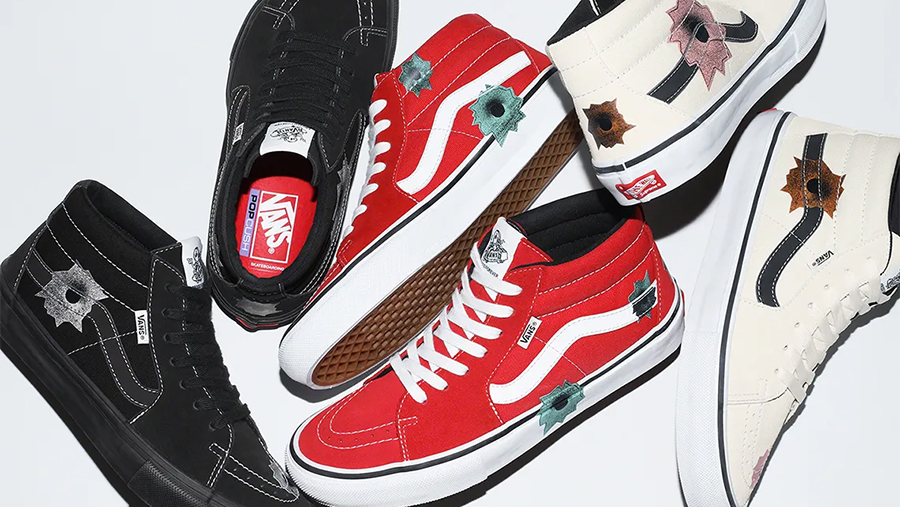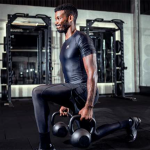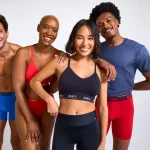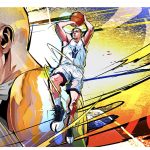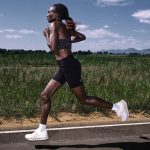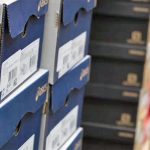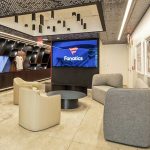While the VF Corp.’s fiscal year started a little more than four months ago, the beginning of a new era in leadership for the company was just 12 days old when new company CEO Bracken Darrell hosted his first conference call with analysts to discuss first quarter results and the challenges, and opportunities, facing the collection of iconic brands he now leads.
While the new CEO is clearly in the listening phase of his new role, after leading Logitech for the last decade as CEO, he deferred most questions and analyses of the business to company CFO Matt Puckett. Darrell’s underlying theme was that he felt at home with his new gig and was impressed with the brands, loyal consumers and the talent available to him at the company.
“VF’s portfolio of globally powerful and iconic brands, deeply embedded purpose and impressive talent, all give me a lot of confidence,” Darrell expressed. “These are the key ingredients needed to unlock the company’s significant value potential and return to strong, sustainable and profitable growth. I joined VF after 10 years as CEO of Logitech, where I’m proud to have overseen a transformation of the company that grew its value tenfold. We did it by putting the customer at the center of everything we do. I’m passionate about building brands through a design and innovation focus.”
Darrell said he feels a strong sense of urgency with respect to the challenges VF faces and assured his audience that they will collectively work with the team to “get VF back on track through disciplined and thoughtful actions.”
The new CEO will need to be a quick study as the headwinds facing his new company appear daunting on the surface. Still, as he peels back the layers he will find a very healthy base of business that can return to strong growth.
For the first fiscal quarter ended June 30, VF Corp., home to the iconic Vans, The North Face, Timberland, Jansport, and Dickies brands, among others, saw 2024 fiscal first-quarter revenue slide 8 percent to $2.09 billion from $2.22 billion in the year-ago quarter. Currency-neutral revenues were also down 8 percent for the period. The quarter was hit particularly hard by the Vans business, which dominates in the first quarter, while the balance of the company tends to excel in the back half of the year.
Two major focuses were identified as key focal areas at the start of the year: the company’s supply chain and the Vans business. On the supply chain front, Matt Puckett said they saw further progress during the quarter as industry conditions continued to improve and the company’s own actions to address execution yielded results. Lead times were again at normalized levels, while on-time performance and in-stock percentages were both said to be back in line with company targets.
“We are appreciative of the quick and aggressive actions taken by the supply chain and brand teams to position us to now consistently meet our customers’ expectations and maximize on the opportunities that present themselves in season,” Puckett said.
Vans
The Vans brand saw sales down 22 percent to $737.5 million in the quarter and was said to be disproportionately impacted by the brand’s wholesale business in the Americas, which was down own 39 percent (-40 percent in constant currency) as the team anticipated based on the order book. The direct-to-consumer (DTC) business for Vans was said to be down in double digits in the quarter as well. Puckett said the overall decline for the brand included intentional actions they took to right-size inventory in advance of the back-to-school season.
“We continue to improve the Vans go-to-market activities,” Puckett said. “Our initiatives to sharpen our focus around fewer key products and stores are well underway and are benefiting the quality and productivity of our store assortments with our in-store skew reduction actions expected to be fully completed in August.”
Still, any expectations of a return to growth in the near term were dashed as Puckett said they expect the Q2 business for Vans to be “less negative” than in Q1.
“We said from the beginning the first half of the year we’ll be relatively challenged given what we see in wholesale and that stays the same,” Puckett explained. “So we’ll see sequential improvement as we move through the year.” He said they hit their internal profit targets for Vans in the first quarter and also met their expectations from a revenue standpoint. DTC is expected to play a larger role in creating growth for the brand.
Puckett said they were encouraged by the results in China and in the digital business, which he said have both “meaningfully improved” relative to the first quarter’s trend versus last year.
“We saw growth in Vans in China in the quarter, so clearly, we’re in a better place there in terms of kind of the inventory reset that’s been underway,” said Puckett. “We’re cautiously optimistic that we’re in a place where we’ll continue to see good results coming out of that region as we move forward across the year overall in APAC. He said Korea has been weaker and Vans is one of their bigger businesses in Korea.
But we’re in a better place. I mean, today with Vans in the region and particularly in China than we were, six months ago. Martino, anything you want to say about, what’s happening on the ground there with the team?
Martino Scabbia Guerrini, EVP for EMEA, APAC and Emerging Brands, chimed in on the call, reflecting on a recent trip to the APAC region, sharing that the Vans business in China was up the high single digits for the quarter.
“When I was there a couple of weeks ago, what I started to see is really a China reopens a very strong engagement from consumers in stores beyond online,” Guerrini shared. “And don’t forget that we’re still under-penetrated in China. We target a growing consumer demographic there. So with a growing emerging middle class, and that’s a big opportunity. And at the same time, as we go back in store and launch a new product, we also drive local for local product and storytelling. So the assets will also benefit from a stronger, for Vans in particular from a stronger local execution.”
He said the recent design center that they created in Tokyo to design and influence across China and Asia is going to drop new products also for Vans specifically in the second half of this year.
Kevin Bailey, president of the Vans brand, added more product focus for the region.
“Localization is really key. China being our newest market, we have to really build classics as an under for the consumer understanding of the brand,” Baily explained “However, they have very specific ask, and as Martino said, we’re leaning into localization to bring what they want from our product to the market. I’d also say they recovered really quickly from COVID on inventories with our partner stores, and that really has given us the opportunity to start moving faster, as Martino said, to achieve the kind of growth we’re seeing in China due DTC. And the last thing I’d really say there is really about skate, skateboarding has taken on a real-life in China as that started to grow, and the team ran a really strong go skateboarding day and we’re really leading there, and we stood up a skate school with one of the big digital players.”
Bailey said that canvas was still not on trend from the search trends, but they are feeling good about where China is and how it’s growing.
But he also cautioned on the over-reliance on the Classics business from a trader’s perspective.
“We became over-reliant on classics and particularly on really just a couple styles, and that really was a big piece of our underperformance and that we didn’t have a strong product pipeline behind it,” Bailey said. “So what you see in these green shoots, albeit small right now, are the opportunities to start pulling franchises beyond classics.”
He said their focus is to stabilize the Classics business and bring style iterations to the market around Classics, which is where he said they are seeing success with their wholesale partners and consumers who want newness. But he said the need to more product propositions around Classics that are adjacent but relevant and give them a greater opportunity to diversify the product pipeline to the consumer.
Bailey went on to say they they are now addressing some of the key frustrations from the consumer.
“So things that we address around style, newness, versatility, comfort, which is what we had been hearing from our consumers, but not responding adequately enough to, are starting to come to fruition with the products that we’re bringing out,” he suggested. “Like the New Skool, like the Lowland, like the Mary Jane, those are nice green shoots. They’re still small at this point and not enough to offset the decline we’ve seen in Classics. However, the work we’re doing in the background to bring bigger stories to the market faster, that will deliver more results, we still feel really confident in.”
But Bailey also saw the need to diversify, saying, “I think in the past, our focus on Classics was so big that it distorted our opportunities and what we’re doing with things like the UltraRange and the MTE growing at double digits, UltraRange, I think up 13 for the quarter, MTE at up 39 for the quarter, that’s really where we believe there’s a lot more opportunity to broaden our product meaning. So those are particularly important.”
“We’re increasing our level of investments to create a new relevant product that excites consumers while developing existing franchises that are working well,” said Puckett.
“However, we still believe execution is the opportunity and what we’re doing with SKU reduction of 20 percent to 30 percent that will be completed in August in our U.S. stores,” Bailey said. “That changes store layouts, simplifies the shopping experience for consumers, but still delivers on the business we want to see. Overall, I think the things we said we were going to focus on are really working.”
Puckett also said a key focus area they shared previously is an opportunity to better understand and integrate the consumer into decision-making. “Our significant global segmentation refresh is on track and in the meantime, our Vans family membership keeps growing, now approaching 29 million members, adding one million members in Q1 and more than doubling in two years,” he shared.
Vans will also be launching a redesigned vans.com platform in time for the holiday season.
The North Face
The North Face delivered its 10th consecutive quarter of double-digit constant-currency revenue growth, up 12 percent to $538.2 million. The brand was said to be up against a tough prior-year comp at +37 percent growth and driven by broad-based growth across products, channels and regions. Globally high demand for key products like the Basecamp duffle, as well as the Voyager Packs, reportedly generated “very strong performance” aided by the summer travel season.
“Our lifestyle product, the urban exploration line and our rainwear also saw good momentum,” shared Puckett. “Growth was led by DTC, driven by digital, as the brand’s product innovation and sharp execution resonated with consumers.”
Timberland
Timberland was down 6 percent for the period to $253.8 million, which was said to be in line with expectations.The brand was up against the tougher prior year compare and results were impacted by wholesale in the Americas as partners continued to reduce inventory levels. Results were reportedly positive in the other two regions.
“Globally, product innovation is resonating as the new hiking silhouette Motion 6 delivered outsized sell-through performance and we made good progress on women’s, with strong growth in sandals and apparel for her,” Puckett said.
Dickies
Dickies revenues fell 20 percent in reported terms (-19 percent in constant currency) to $136.6 million in the quarter.
“Dickies results were disappointing and significantly challenged during the quarter, down 19 percent, as the work segment continues to be impacted by a weaker value and consumer, primarily in the U.S. Soft results in the Americas and APAC were partially offset by continued growth in Europe. Importantly, we have made progress on rightsizing inventory levels in the channel,” Puckett said.
“I think just to be frank, the business continues to be impacted by soft results in the Americas and in that work channel sell-through is falling short of expectations,” he continued. He said they continue to see outsize impacts from some of the challenges in the marketplace that are impacting the value consumer more so than what they see in other parts of the business.
“If there’s a bright spot to some degree, our inventory positions are now in a pretty good place,” Puckett added. “In particular, our largest account, they’re in a better place. And, if sell-through improves across the pad, and certainly for us, for Dickies we’re in a position that we can capitalize on that and we’ll see a nice replenishment pop at some stage.”
Still, he said, the underlying sell-through to date has continued to be short of expectations.
“Europe continues to grow [for Dickies],” he said. “I think that’s another thing and driven by the lifestyle part of the business that’s been important to us. But ultimately we’ve got to, we’ve got work to do here to improve that basic work business in the U.S. and ensure we’re driving that business effectively. And so that’s a big focus of the team today.”
Other Brands
Other Brands, comprised of Altra, Jansport, Smartwill, Icebreaker, and others, grew 7 percent to $420.2 million in Q1 2024.
Puckett said the Packs business, which includes Jansport, Kipling and Napapijri, continues to perform well.
“If anything’s a little better in Q1 than we anticipated, and it’s set up for a really good back to school,” he said. He said they grew the top line “nicely” last year across the year top- and bottom-line, and that continued into the first quarter.
“These brands continued to kind of have momentum and benefit from, consumer trends,” Puckett responded when asked about the previous announcement that VF was looking to divest the business. “But I’d be remiss if they didn’t say how happy and proud I am of the team and the work that they’re doing, not an easy environment when you know, kind of what’s going on around them with all the conversation that you ask about is happening. And they continue to do amazing work in that regard. So really impressed by what’s happening there. The process is continuing, it takes time. There’s a lot of interest [in the business].
“We’re progressing discussions with a number of parties and we’ll be disciplined in the deal-making, especially in light of who the business is,” he continued. “The results are good. We’re generating good growth. We’re generating, strengthening EBITDA, and, acknowledging where the capital markets are today. We’re just not going to accept the valuation we’re not comfortable with. And until we find the right buyer for these brands at a valuation that we’re happy with, we’ll continue to be very discerning. So that’s kind of the update I’d give you there.”
The overall Wholesale business was down 12 percent in the quarter, including an 18 percent decline in the Americas region. Direct-to-consumer was down 3 percent (down 2 percent in constant currency) in the quarter but up 6 percent excluding Vans (up 7 percent in constant currency).
From a regional perspective:
- The overall Americas market was down 15 percent to $1.18 billion for the quarter.
- International markets revenue increased 3 percent (up 4 percent in constant currency) to just over $1.0 billion.
- Greater China was up 24 percent (+31 percent in constant currency), leading further improvement in the APAC region to generate a 13 percent increase (+18 percent in constant currency).
- EMEA revenue was down 2 percent (down 3 percent in constant currency) in Q1, reflecting continued growth in DTC, but lower wholesale revenue.
Consolidated gross margin was 52.8 percent of sales in the first quarter, down 110 basis points versus the prior-year quarter. Adjusted gross margin was 52.8 percent, down 130 basis points year-over-year, due primarily to increased promotions.
Adjusted gross margin headwinds include 200 basis points of unfavorable rate impact, including promotions, and 10 basis points of adverse foreign currency exchange rates, partially offset by 80 basis points of mix benefits
Operating margin (0.4) percent, down 320 basis points; adjusted operating margin (0.4) percent, down 380 basis points.
Adjusted operating margin contraction driven by 130 basis points of unfavorable gross margin impact and 250 basis points of deleverage.
The net loss expanded to $57.4 million, or a loss of 15 cents per diluted share, in Q1, compared to a loss of $56.0 million, or 14 cents per diluted share, in the prior-year first quarter. The adjusted loss per share was 15 cents loss per share versus adjusted earnings per share of 9 cents in the year-ago quarter.
Inventories increased by $446 million at quarter-end, up 19 percent relative to the comparable point last year, primarily driven by core and excess replenishment inventory, VF modified terms with the majority of its suppliers in the first quarter of fiscal 2023 to take ownership of inventory near point of shipment rather than destination; this program has now been fully lapped in the first quarter.
Outlook
Looking ahead, the company reiterated its full-year EPS guidance range of $2.05 to $2.25 per share but revenue is now expected to be “modestly down to flat” for the year, reflecting ongoing weakness in the wholesale business and a longer-than-anticipated turnaround for Vans.
Photo courtesy Vans

